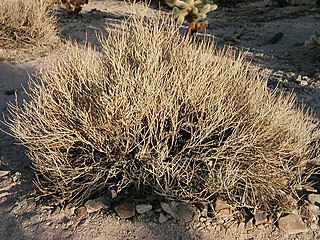
Senna covesii is a perennial subshrub in the family Fabaceae, native to the Mojave Desert and Sonoran Desert in southeastern California, southern Nevada, and Arizona in the United States, and northern Baja California in Mexico. It is found on desert plains and in sandy washes between 500 and 600 m above sea level, and is very common in Joshua Tree National Park. The specific epithet honors ornithologist Elliott Coues.

Dalea searlsiae, commonly known as Searls' prairie clover, is a perennial legume species belonging to the Dalea genus. The species is found through arid regions of the southwestern United States and can survive in low moisture conditions. The species forms symbiotic relationships with nitrogen-fixing bacteria that can improve soil nutrient levels. Its large inflorescence attracts many species of pollinators, and it lacks toxins found in similar legume species. As a result, the species has been considered for use in rangeland restoration and revegetation projects.
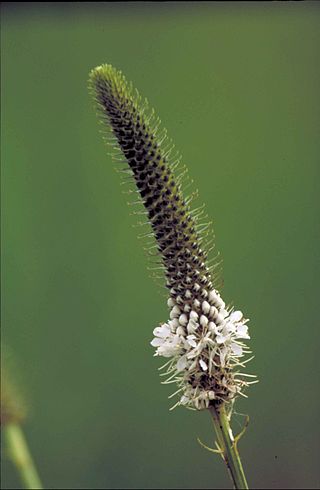
Dalea is a genus of flowering plants in the legume family, Fabaceae. Members of the genus are commonly known as prairie clover or indigo bush. Its name honors English apothecary Samuel Dale (1659–1739). They are native to the Western hemisphere, where they are distributed from Canada to Argentina. Nearly half of the known species are endemic to Mexico. Two species of Dalea have been considered for rangeland restoration.

Ratibida columnifera, commonly known as upright prairie coneflower, Mexican hat, and longhead prairie coneflower, is a perennial species of flowering plant in the genus Ratibida in the family Asteraceae. It is native to much of North America and inhabits prairies, plains, roadsides, and disturbed areas from southern Canada through most of the United States to northern Mexico.
Dalea mollis is a species of flowering plant in the legume family which is known by the common name hairy prairie clover.

Dalea mollissima is a desert wildflower plant in the legume family (Fabaceae), with the common names soft prairie clover, downy dalea, and silk dalea.
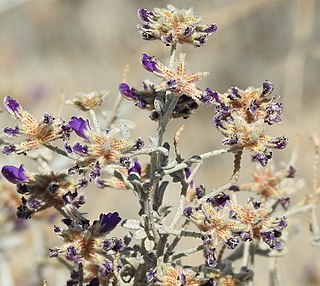
Psorothamnus emoryi, common names dyebush, white dalea, or Emory's indigo bush, is a perennial legume shrub or subshrub common to the desert mesas of the southern part of the U.S. states of Arizona and California, and regions of the Mexican state of Baja California.
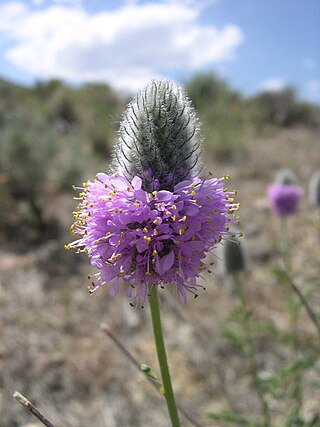
Dalea ornata, the Blue Mountain prairie clover, is a perennial subshrub or herb of the subfamily Faboideae in the pea family (Fabaceae).
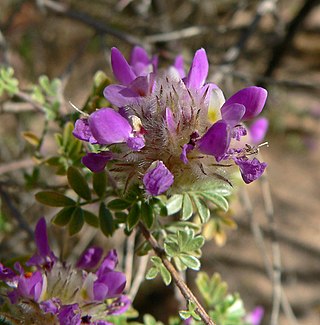
Dalea pulchra, the Santa Catalina prairie clover or indigo bush, is a perennial shrub or subshrub of the subfamily Faboideae in the pea family-(Fabaceae). It is found in the southwestern United States and Northwestern Mexico in the states of Arizona, New Mexico, Sonora, and Chihuahua, in the Madrean sky islands region and associated areas.

Zerene cesonia, the southern dogface, is a North and South American butterfly in the family Pieridae, subfamily Coliadinae.

Marina parryi is a species of flowering plant in the legume family known by the common name Parry's false prairie-clover. It is native to the deserts of the southwestern United States and northern Mexico. This is a perennial herb producing stiff, branching stems 20 to 80 centimeters long. It is coated with glands and rough hairs. The leaves are made up of several pairs of small oval leaflets no more than 6 millimeters long. The inflorescence is a raceme of deep blue and white bicolored flowers each under a centimeter long. The fruit is a legume pod containing a single seed.

Dalea foliosa, commonly called leafy prairie clover, is a species of flowering plant in the legume family (Fabaceae). It is an endangered species in the United States, where it occurs in three states: Illinois, Tennessee, and Alabama.

Phlox diffusa is a species of phlox known by the common name spreading phlox. It is native to western North America from British Columbia to the southwestern United States to the Dakotas, where it grows in many types of habitat, including rocky, high elevation mountain slopes. It is a very compact mat-forming perennial herb growing in cushions or patches of short, decumbent stems. The linear, lance-shaped, or needle-like leaves are no more than 1.5 centimeters long and are oppositely arranged in bundles on the short stems. The inflorescence is a solitary tubular flower around a centimeter long. It has a flat white or pale pink or blue corolla with five lobes each just under a centimeter in length.

Dalea candida is a species of flowering plant in the legume family known by the common name white prairie clover. It is native to North America, where it can be found throughout central Canada, the central United States, and northern Mexico. It can sometimes be found outside its range as an introduced species. It grows in many types of habitat, including several types of prairie, foothills, woods, forests, and disturbed areas.
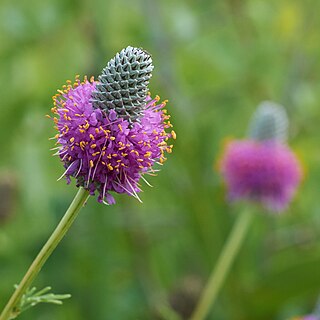
Dalea purpurea is a species of flowering plant in the legume family known as purple prairie clover. Native to central North America, purple prairie clover is a relatively common member of the Great Plains and prairie ecosystems. It blooms in the summer with dense spikes of bright purple flowers that attract many species of insects.
Dalea carthagenensis is a species of flowering plant in the legume family known by the common name Cartagena prairie-clover. It is native to the Americas, where it is found in South America, Central America, the West Indies, and the US state of Florida.
Dalea neomexicana, the downy prairie clover, is a perennial plant in the legume family (Fabaceae) found in the Sonoran Desert and grasslands of southeastern Arizona to western Texas and into Mexico. Its common name refers to its silky hairs covering it.

Dalea aurea, commonly called golden prairie clover, is a species of flowering plant in the legume family (Fabaceae). It is native to North America, where it is found in the Great Plains and southwestern United States, and in the state of Coahuila, Mexico. Its natural habitat is in silty or gravelly prairies, often over limestone.

Dalea multiflora, commonly called roundhead prairie clover, is a species of flowering plant in the legume family (Fabaceae). It is native to North America, where it is found in Mexico and the United States. In the U.S., it is primarily found in the Great Plains and South Central regions. Its natural habitat is in dry rocky prairies, particularly in limestone soils. It is a conservative species and can be indicative of undisturbed prairie communities.

















